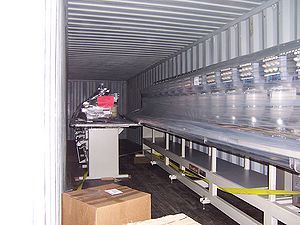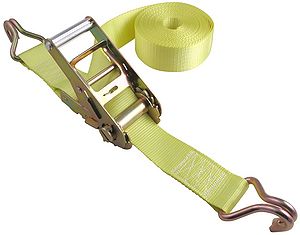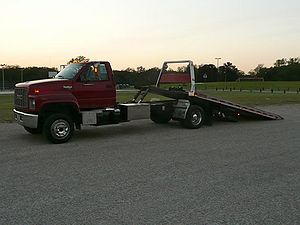Shipping Procedures for LTL or a Full Truck (large machines)
The following Shipping Procedures for LTL or a Full Truck (large machines) can be used when transporting large embroidery equipment.
Large embroidery equipment can be any embroidery machine that WILL NOT fit on a pallet or inside a crate. Generally large machines will have 4 or more heads but usually are 6 or more heads. However it really depends on the physical lengths and widths of the machine. If the machine can not fit on a large pallet or a pair of pallets or, the machine cannot easily be crated then the machine is probably considered a large machine. Usually machines larger than or equal to 6 heads are better shipped LTL. LTL stands for Less Than Truckload and means that the machine will need to be shipped in a large commercial shipping truck and not crated or palatalized. LTL means paying for a section, sections, or all the truck.
Shipping
To ensure the machine(s) purchased by the client arrives in the best condition possible, follow these simple shipping and receiving instructions:
Packaging
- Make sure the machine and accessories are cleaned and complete.
- Package all the accessories in boxes. Tape the boxes and label the boxes with the buyers contact and shipping info.
- Make sure the machine is on the middle needle so that the heads are centered. If the heads are not centered, they might vibrate loose.
- Wrap up power cable and tuck it away so it doesn't get damaged.
- Threads should be pulled through about 1 foot from the tip of the needles and then tied off together and attached to the thread holders.
- Spools of thread should be pulled about 1.5 feet out from the first eyelet it enters on the machines and then cut off. The threads should then all be tied off together just left to hang.
- If the machine has a thread rack that can be very easily removed or lowered then remove or lower it.
- If the machine has any large halogen tube lights, then should be removed and discarded of.
- Place the accessory boxes that were packed up earlier on or under the machine. Make sure the boxes are secured to the machine. If there is not room to put the boxes anywhere, they can be shipped with the same truck separately but must be labeled properly with the buyers contact info. Try to attach any large items such as the cap driver or tubular sash onto or under the machine do it does not get damaged on unloading.
- Put stretch film or plastic around the machine to protect it from the weather or other merchandise that will be on the truck. Protect any sensitive parts such as the control panel or the heads. Place cardboard around the corners or anywhere else that might get damaged.
- Take a picture of machine packaged and send them to the buyer to verify and approve before shipping.
Loading
If the seller does not have the personnel or equipment to load the equipment, then the seller might need to contact a local rigging company. The rigging of the equipment is generally at the sellers expense.
{{
{{#invoke:Namespace detect|main}}
| type = | image = {{#if:|[[file:{{{image}}}|40px|Notice]]}} | imageright = | class = | style = | textstyle =
| text = {{#if:|
}}Extreme caution is needed when moving these machines. Embroidery equipment is generally top heavy which means its very easy for the machine to flip over when moving. Again, extreme caution needed when moving the equipment.
| small = | smallimage = {{#if:|[[file:{{{image}}}|30px|Notice]]}} | smallimageright = | smalltext = | subst = {{subst:substcheck}} | date = | name = Notice }}
- If a dock is available at the pickup location then loading the machine into the truck should not be a problem. A fork lift might be needed. If the machine does not have industrial casters then industrial casters or piano moving equipment might be needed.
- If a dock is not available then a flatbed Wrecker might be needed.
- The flatbed operator can lower the bed of the truck to pickup the machine using the winch. The flatbed wrecker should then back up to the shipping truck so that the equipment can be unloaded from the flat be wrecker into the truck.
- The machine should be placed as close as possible to the cab (front part) of the truck. Wheels/Caster must be removed.
- 2' x 4' blocks of wood can placed around the feet of the machine and nailed to the floor to keep the machine from shifting.
- Ratchet Cargo Straps should be used to secure the machine to the floor and/or the walls of the truck. Make sure plenty of straps are used and that the machine is secure enough to keep from flipping over in transit.
- Once the equipment is loaded, take pictures and send them to the buyer.
- Ask the driver to sign a copy of the BL and send it by fax or email to the buyer.
Receiving
When receiving a large embroidery machine shipment, follow the following steps to ensure the machine arrives properly and is setup to run without any problems
Unloading
If the buyer does not have the personnel or equipment to unload the equipment, then the seller might need to contact a local rigging company. The unloading rigging of the equipment is generally at the buyers expense.
{{
{{#invoke:Namespace detect|main}}
| type = | image = {{#if:|[[file:{{{image}}}|40px|Notice]]}} | imageright = | class = | style = | textstyle =
| text = {{#if:|
}}Extreme caution is needed when moving these machines. Embroidery equipment is generally top heavy which means its very easy for the machine to flip over when moving. Again, extreme caution needed when moving the equipment.
| small = | smallimage = {{#if:|[[file:{{{image}}}|30px|Notice]]}} | smallimageright = | smalltext = | subst = {{subst:substcheck}} | date = | name = Notice }}
- Before unloading anything, inspect the equipment for any serious damages. Take pictures of any damages. If there appears to be any problems or serious damages, its best to contact the shipping company and/or seller for further procedures. Once the equipment is unloaded from the truck it might be difficult to claim insurance if damage's were incurred during shipping. Sellers are not responsible for any damages incurred during shipping.
- If a dock is available, unloading the machine from the shipping truck should be no problem. A fork lift might be needed. If the machine does not have industrial casters then industrial casters or piano moving equipment might be needed.
- If a dock is not available then a flatbed Wrecker might be needed.
- The flatbed wrecker should back up to the shipping truck so that the equipment can be unloaded from the shipping truck to the wrecker.
- The flatbed operator then can lower the bed of the truck to lower the machine back to the ground.
- Once the machine is unloaded from the truck, it should be moved to its final embroidery location
Setup
- Remove all plastic wrap or protection from the machine.
- If the machine has feet, put them on at this point. A very high capacity shop jack might be needed.
- The machine need to be as perfectly level as possible using the feet levelers. Most all machines and stand have leveling feet. If the machines is not perfectly level, it will vibrate causing thread and needle breaks and poor embroidery quality. The machine might also rattle or not sound as good as it would level. If the machine is very long, it might need more support in the middle.
- If the machine has a thread rack that has been removed or lowered, set it back up. The machine will need to be threaded and each individual needle will need to have its tensions reset manually once the machine is running. Add a new fresh bobbin. If the machine uses halogen lights, install new ones at this point.
- It is highly recommended to have an Embroidery Machine Technicians inspect the equipment first before applying power. The power outlet should also be inspected to ensure its outputting the proper power amount for the equipment. The machine should also be inspected to make sure its set on the right power requirements that the building is outputting. A 110V machine connected to a 220v outlet will cause serious damages to the electronics.
- Oil the machine according to the manufacture specs. The machine may have lost all its oil during shipping. Do not over oil the machine or the oil might damage electronics.
- Once the machine and power has been inspected and it has been oiled, the machine should be ready to connect and power up.
- Its recommended not to run the embroidery machine until the operator has been properly trained to avoid headaches or very basic operator errors.
- Using a very basic logo or test shapes, embroidery on each needle using scrap material until all the oil has coated and excess oil has dripped off. The tensions should be set during this time. If the machines has more than one head, it is sometimes easier setting tensions head by head rather than all of them at the same time. When setting up its recommended to work with just one head at a time. If a head has many problems, its usually best just to turn it off until an Embroidery Machine Technicians can look at it.
- After running the machine for about a day with scrap material check again that it is level. If the machine has been running properly then it should be ready for production embroidery work.







